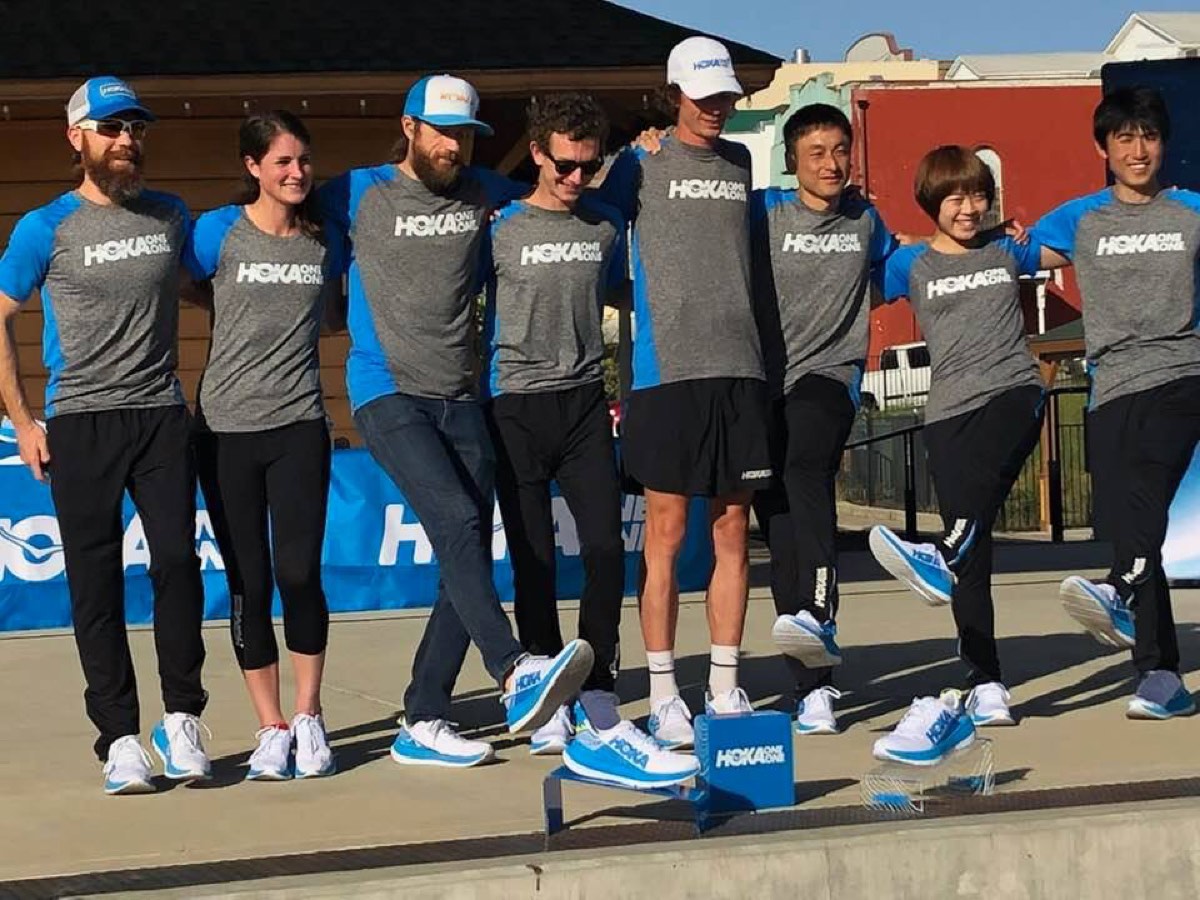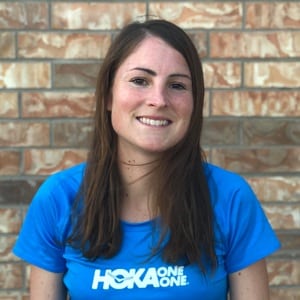It’s just before 6 a.m., and I am standing in the middle of a street somewhere outside of Sacramento, California. I am shoulder-to-shoulder with my teammates. The nerves are palpable, but we don’t talk about it. We just stretch and laugh about other things. Just before the start, I make eye contact with Aiko Kanematsu of Japan. We don’t speak the same language, so throughout the weekend we have been chatting through a translator. I consider Aiko a friend now, and our friendship will significantly deepen over the shared difficulty we are about to undergo. We smile at each other, and the gun goes off. Suddenly we are off running.
Today, I will try to run as fast as I possibly can for 62 miles. Unlike other races, in which I might respond to the moves of my competitors, my attempt will look like this: I will try to empty my energy in consistent intervals, like one does when he or she wants to make a tube of toothpaste last for a given amount of time. If I execute well, I will be out of toothpaste as soon as I cross the line. But as the race proceeds, I start to wonder whether I have judiciously expended my toothpaste and have saved enough to get me to the finish.
There are two types of writing: showing and telling. Usually in my column, I tell you things. This time I want to show you, in the form of a race report. What I want to show you is that it is morally productive to set lofty goals and fail to meet them. I also want to show you that mixed emotions at the finish line are both certainly my experience and often appropriate.
Fast Facts
Event: Hoka One One Project Carbon X
Date: May 4, 2019
Location: Folsom, California
Details: 100k race, with a measured 50k and 50 miles en route
Significance: Release of Hoka’s new Carbon X racers. They are fast.
Results: 7:49 for 100k (about 11th or 12th in U.S. history), with ninth-fastest 50-mile in U.S. history on the way. Goals met? None.
Relevant Literature: Homer’s Odyssey, John Bunyan’s Pilgrim’s Progress
Baselines
Back in December, Hoka’s senior global sports marketing manager, Mike McManus, invited me to be a part of Project Carbon X. When I received the call, I was sitting on the couch at my dad’s house in New York, where we were celebrating Christmas. I had just finished an easy run in the snow, and I was two weeks removed from a workout, since I was recovering from an early December 50k. What I mean is, running hard was a cheerful, distant memory, colored by nostalgia through the lens of that recent success. I don’t know about you, but it takes me very little time to forget what it feels like to run hard. I forget the difficulty of it, and I want to do it all over again.
I said yes to Mike, excited about the nature of the challenge. There is nowhere to hide in a road race. There is more control, since you are not beholden to the course topography for pacing. You certainly can’t blame the course for your failures. It would be an honest appraisal of where I was, and that was what I wanted. Or, really, that was what I needed, in order motivate my improvement as an athlete.
Once committed, I evaluated two things:
- my baselines or my current level of fitness without specific training, and
- my goal, or telos.
In virtue ethics, the distance between a person’s baselines and their goal is called a character gap–“the space between how we really are, and the people of good character we should become.” (1) In running, I guess you could call this a fitness gap—the space between where we start a training cycle and the athletes we want to be on the other side. We can work to close this gap through deliberate practice. This is, in essence, what training is.
Training is reshaping, and reshaping is hard. To do this, I put habits in place that will form me in the right ways, to achieve the particular end. This is structurally similar to how I acquire virtues in the moral domain:
- In life, I practice honesty in small, big, and manifold ways so that, when I am tested, I will be dependably honest.
- In running, I practice being able to compete at a given level in small, big, and manifold ways so that, when I am tested, I will be fit for the task at hand.
So, I did this. From January to May, I worked to close the gap between the person I was in December and the athlete I wanted to be on May 4th. I learned a lot, and it was hard.
The Race
Here is my brief testimony of the events that occurred on May 4th:
I went out fast, probably too fast. I did this because it was the cool of the day and I had a pacer for the first stretch. The first 18 miles were on a rolling bike path, which felt faster than the loop section, so I didn’t mind rolling a bit on that section before finding my pace on the loop. Nothing felt forced, and I knew that I could pull back and regroup a bit, then press again. It would be just like interval training, and I had practiced for that. At around 20 miles, this was what I did. I pulled back a bit to get more nutrition down, and when I went to step on the gas again, there was not much there. There were 42 miles left, which never seemed insurmountable, but I struggled with pressing the pace again (i.e. locating my toothpaste). I had low energy and my stomach did not want to follow my eating plan in the heat, so I settled into a pace I could sustain and hunkered down for the journey. Rule #1 of ultramarathoning: A ship captain always completes the journey, no matter what storms are encountered in the high seas. Batten down the hatches and keep going.
When I eventually crossed the finish line having achieved none of my goals, I was pleased.
I was grateful, joyful, ebullient, thirsty, and excited. I was also disappointed.
The Finish Line
Sometimes people apologize to me when I don’t reach my goals, or they speak about it tenderly or present me with a range of excuses that I can use. (“That was pretty good race for you considering X.” “That was fast in the heat.”) I appreciate it, but you don’t need to protect me from my goals. My joy is like a buoy. You can push me under water, but I won’t stay there. And, actually, my disappointment is fitting and productive in this context, and not at odds with my joy. My personal failures are an occasion for work, but not a cause for despair.
I used to have this same tendency when I coached athletes. Before the race, we would speak firmly and specifically about their goals, and if they failed to reach them, I would want to cushion their fall in some way, explaining it away for them so they wouldn’t be disappointed.
But this involves a type of revisionary history—denying that the goal existed or not allowing them to experience their character gap or fitness gap, or whatever we are calling it. I became afraid that softening my athletes’ disappointments in this way would encourage them to think in these terms while racing—denying that the goal existed as soon as it became a challenge. And I worried that only allowing them to embrace their personal bests, while explaining away their failures, would be a disservice to them because they would not learn to graciously fail. Personally, I am drawn to people who graciously fail, and I want to be one. Because, consider this: If you are only gracious when you win, that’s probably not really graciousness. It’s just getting your way.
Running is a weird world. We taut our personal bests (our PBs or PRs), define ourselves in terms of these numbers, and recite them to one another. But we ignore the fact that our personal worsts are just as descriptive of us as athletes as our personal bests are. It seems like people want to claim their successes and explain away their failures, but you can’t do both. Your best and your worst are both yours.
So, this is what I want to do here, on the occasion of my hard race in Folsom: I want to claim this race as an honest appraisal of my running, without any excuses. And I want to hold it up, side-by-side alongside races that have gone really well, so that I can learn from both.
Final Thoughts
On Saturday I tried to run as fast as I could, and I did not reach any of my goals. But this spring, I moved in the direction of the athlete I want to be, closing the fitness gap just a bit. I’m not the athlete I want to be yet, but I’m a better athlete for having set goals in the first place.
Call for Comments (from Meghan)
- Comparatively, what space do you give success and failure in your psyche? In various aspects of life? In running?
- And what about our trail running and ultrarunning communities, do you think we allow ourselves to consider failure as we do success?
References
- Miller, C. (2018). The Character Gap: How Good Are We? New York: Oxford University Press.

